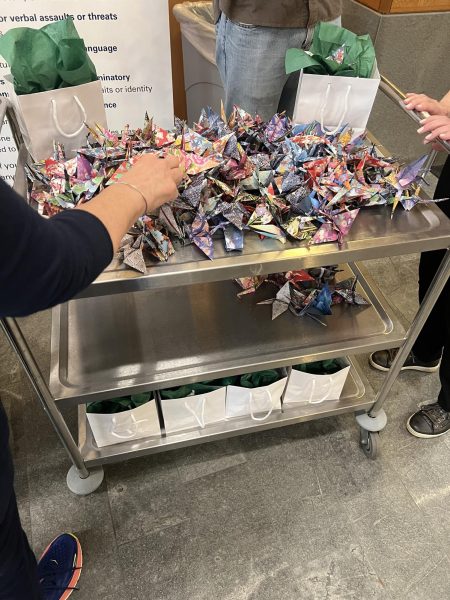Throughout April, dozens of students in 2B worked together to collectively fold 1,000 cranes for cancer awareness. According to organizers, the goal was to finish the project by the start of May, which students accomplished by reaching their target a few days before the end of the semester two weeks ago. In the coming months, the majority of the cranes will be distributed to cancer patients at nearby Dana-Farber Cancer Institute.
The event was inspired by the story of Sadako Sasaki, a 2-year-old living near ground zero of the Hiroshima bomb when it dropped in 1945. She was later hospitalized with leukemia as a result of radiation exposure. It was there that she was gifted her first paper crane from a visiting friend, an animal symbolizing good fortune in Japanese folklore. She learned of Senbazuru, the tradition of folding 1,000 cranes to grant a wish, often for healing. Before her death in 1955, Sasaki completed the cranes. Fifty years later, on April 28, the students of 2B did the same.
‚ÄúI really didn’t think that it would happen,‚Äù Christian Jones, a resident assistant in 2B who organized the event, said of the goal to reach 1,000 cranes. ‚ÄúI was hopeful, but the thought of people just taking so much time out of their day and like sitting in this public space, to do this [surprised me].‚Äù
Besides putting out pieces of paper for folding and a box for collection in the 2B lobby, Jones said the project ran largely autonomously, which meant its success was largely up to community response.
‚ÄúI was really surprised to see the level of community engagement that the project drove up,‚Äù Jones said.¬Ý
He said the idea for the project came a few months ago when he noticed a resident of his had disappeared from campus for over a month, followed by an announcement on social media of a cancer diagnosis.¬Ý
“That was just kind of like a shock to me, I was like, ‘Wow, someone our age, one of my residents [dealt with that and] also just kind of kept it to [themselves],’” Jones said.
While the student ended up being treated on medical leave, for Jones, this event, coupled with the passing of recent journalism graduate Nora Onanian to a rare bone cancer last fall, inspired him to want to do something for cancer awareness in the Emerson community.¬Ý
‚ÄúCancer isn’t this distant thing that only happens to people when they’re older ‚Ķ It can happen to people our age, and it’s just like a really scary, kind of isolating thing,‚Äù said Jones, whose uncle was also recently diagnosed with leukemia. ‚ÄúI wanted to see if there was something I could do about that.‚Äù
Then he remembered the story of the Sasaki, which his mom had told him about earlier that year.
The initiative launched on April 4 with an email from 2B’s residence director, who also helped to coordinate and supply materials. The email explained that if each resident in the building folded just three cranes, the project would surpass its goal.
For Ahni Brown Harbin, a sophomore writing, literature and publishing major with previous crane-folding experience, that pitch immediately hooked her. She spent several nights origaming at odd hours and building a community bond around a shared goal. The anxieties of approaching finals made the activity even more appealing for her.¬Ý
“Us[ing] my anxious energy to fold the paper cranes and create things out of my anxiety was really empowering for me,” Harbin said, “and having a good cause for it to go to was also a definite motivation.”

Harbin said she relates to the feeling of community need for the project and got her roommate, whose dad recently received a cancer diagnosis, involved with the project. Harbin also contributes to WERS and remembers crossing paths with the late Onanian, who worked for the radio station.
‚ÄúWe just lost her, so it was kind of cathartic and amazing to know that I was making a difference,‚Äù Harbin said.¬Ý
Even non-2B residents like Avery Piazza, a junior theater major living in Piano Row, contributed to the project.
‚ÄúI didn’t realize how big it was ‚Ķ It’s so cool how the whole building was part of it,‚Äù Piazza said. ‚ÄúThey were working towards a common goal [and] I thought it was really beautiful.‚Äù
While she, like others, faced a learning curve in the origami process, she said she also found fulfillment in it.
‚ÄúIt’s difficult to get the hang of it first, but once you learn how to do it, it’s a really calming process ‚Ķ I found it very meditative,‚Äù Piazza said.
![]() In the end, the project went on to surpass its goal by roughly 20 cranes. Six hundred of the cranes will be donated to Dana-Farber patients in goodie bags, with 280 cranes already distributed to hospital patients on May 7, and another 320 more planned for donation next month. The remaining cranes are planned to be displayed as an art installation in the 2B lobby next semester.
In the end, the project went on to surpass its goal by roughly 20 cranes. Six hundred of the cranes will be donated to Dana-Farber patients in goodie bags, with 280 cranes already distributed to hospital patients on May 7, and another 320 more planned for donation next month. The remaining cranes are planned to be displayed as an art installation in the 2B lobby next semester.
‚Äú[It feels good] knowing that I can do something even if it’s a tiny little square of paper that I folded into the shape of a bird and brighten [someone‚Äôs] day a little bit,‚Äù Harbin said.